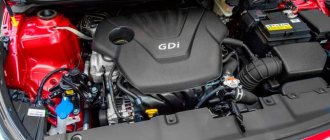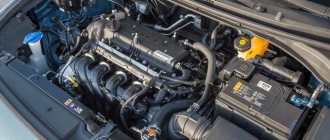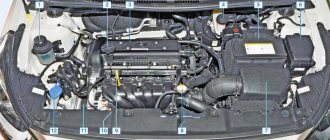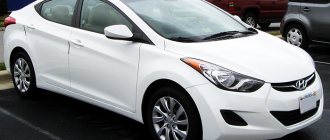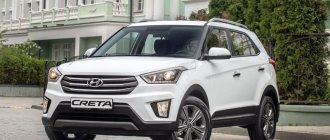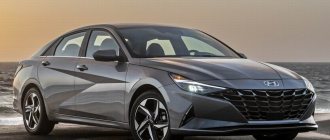Story
The popular “Korean” of the small class, the Kia Sid, made its first public debut in 2006 in the French capital. The developers immediately stated that the model was developed exclusively for the European market, as evidenced by the name, which is an abbreviation. The company's branches could boast of high productivity, and by the spring of 2008 a total of 200 thousand copies of Sid models had been assembled.
In 2009, the car underwent restyling, which was associated with the new corporate style of the company. In 2012, the developers introduced Sid 2, which received a new design and was also recognized as one of the best in terms of safety in the segment. The car was recognized as the best in Poland, Slovakia and Sweden for several years in a row.
Hyundai Solaris is a Korean subcompact car, which is the direct successor of the Hyundai Accent 4. Solaris was created specifically for the domestic market, and represents an adapted version of the Accent for Russian road conditions. The premiere of Solaris took place in early autumn 2010, and assembly processes immediately began in St. Petersburg.
In May 2014, a restyled version of Solaris was presented, which received an improved suspension and transmission. The second generation model is expected to be released soon.
Which is better – Sid or Solaris? If we talk about career success, then naturally it’s Kia Sid.
Which car is better - comparison of Kia Ceed and Hyundai Solaris
South Korean-made cars are becoming increasingly popular in the world market. This is due to the fact that the level of production in the country has increased significantly. Over the past few years, many interesting cars have rolled off the assembly lines of various factories in Korea. They are able to compete with products from any other country, since they not only have good quality and equipment, but also a modern, original design, and also do not require a lot of money for purchase, maintenance and repair.
Competitors from Korea Kia Ceed and Hyundai Solaris
An economical car of the middle or small middle class (C and B by European standards, respectively) is perhaps the dream of most drivers. They have the optimal size for driving around the city, but are also great for family or work needs - going to the country house or to the store, or carrying a small load. As for C and B-class cars from Korea, they completely fit into the concept of the city and attract primarily by price, equipment and appearance.
Having decided to purchase a Korean car, the car enthusiast begins to study the relevant sources and comes across several interesting offers at once. The most popular compact and subcompact Korean cars are the Kia Sid and the Hyundai Solaris - most buyers in this market segment make a choice between these models. Of course, comparisons based on appearance and declared data are not enough. I would like to know which car is the best so as not to make a mistake when buying. To do this, you need to make a detailed comparison according to all criteria.
Description of Hyundai Solaris
The car is also produced in South Korea, but at a different plant. The line of cars was released in 2011 - it was created with the aim of replacing the Accent 4 in Russia: the car has several minor changes in the ergonomics of the body and interior, as well as a nice bonus for our frosts - a heated windshield. Solaris is no less widespread on the Russian market than Sid. In 2014, Hyundai received the Car of the Year award for its large number of sales. Compared to its competitor, Solaris compares favorably with the price of the base model - it is noticeably lower. In addition, in the car line there is not only a hatchback, but also a sedan, which Sid does not have.
Hyundai Solaris hatchback
Comparison of Sid and Solaris
Despite the fact that these two cars were produced in the same country, which implies some similarities, they have no less differences. The Sid is a middle-class car and is available in hatchback and station wagon body styles, while Solaris is produced in the form of a sedan and hatchback. In addition, they differ significantly in their configurations and prices.
Options
The basic configuration of the Kia Sid will cost the car enthusiast approximately 730,000 rubles. It includes:
- Side and front airbags, as well as curtains;
- Folding seats;
- Adjustable steering column;
- ABS;
- ESS;
- Immobilizer;
- Increased ground clearance for Russian roads (not relevant for the GT version);
- On-board computer;
- CD system with six speakers;
- Electric drive of windows and mirrors.
Appearance
In terms of appearance, the cars are absolutely authentic. In the exterior of the Sid, innovation and high technology are noticeable, combined with flamboyance and stylish design. Another thing is Solaris - outwardly the car looks simple and practical, or, in other words, it has the typical appearance of a representative of the subcompact class.
The elements of the front of the cars are arranged in completely different concepts. In front of the Sid, I would like to note the stylish air intake and cool foglights. Solaris, in turn, is able to surprise with its smooth hood and powerful bumper.
It is almost impossible to find similarities on the sides and behind the cars, they are too different. But, in profile, it is noticeable that the Kia Sid has a more aerodynamic body shape.
Due to the fact that more bold design solutions can be observed in the exterior of the Sid, it is he who is the winner in this regard.
Bottom line
A detailed comparison revealed that Solaris is more of a utilitarian car - simple equipment, but excellent technical data allows it to last longer, initially saving the buyer a lot of money.
Kia Sid, on the contrary, compared to Hyundai, is more prestigious and focused on driving pleasure. It is not well suited for transport or travel on dirt roads. The cars are united by build quality and its optimal price-to-cost ratio.
Korean automobile giants never tire of delighting their fans with practical and balanced passenger cars in an affordable price niche of the market. Next, we will present an overview of two popular “Koreans” and try to compare in detail and understand which of the presented cars is better, Kia Rio or Hyundai Solaris.
Salon
However, regarding the interior, the situation is completely opposite. It is the interior decoration of Solaris that is the favorite in this local confrontation. Yes, the Sid’s interior is very technologically advanced and meets all European standards, but its opponent managed to jump ahead due to the successful layout of internal elements and high ergonomics. In addition, Solaris has better quality upholstery. Although in terms of capacity, both models are approximately equal.
Chassis system
The basic configuration of the Kia Sid can quickly accelerate to 100 km/h. The manufacturer claims that this requires only 12.7 seconds. But at the same time, the consumption is quite high, about 8 liters per 100 kilometers, sometimes the mark can reach 10 liters. At the same time, the owners note that this Korean is very poor at maintaining low revs, so the driver constantly has to use his balancing skills between high speed and fuel consumption.
The Sid, when compared to the Hyundai Solaris, has a rather poor suspension. The rear beam creates a rigid feel. The car itself bounces even on the slightest bumps, which has a very bad effect on comfort. The creators corrected this flaw, but still not completely. The suspension became volatile, but the control became “tight”.
Hyundai Solaris accelerates quite well when compared with its pursuer, even the basic version accelerates to 100 km/h faster, in just 11.5 seconds. But fuel consumption is practically the same.
Experts also note that the Hyundai Solaris has a very good gearbox, and the suspension is well tuned and works in such a way that small bumps and holes are not felt. In terms of comfort, they may be similar, but if we compare cars in dynamics, then Solaris wins and does so by a large margin. But you won’t feel this on smooth asphalt.
Specifications
To compare the technical characteristics of Sid and Solaris 2021, we used versions of the models equipped with 1.6-liter gasoline engines. Among other similar points, it is worth noting the front-wheel drive system and the same type of transmission - a six-speed automatic.
As for the engines themselves, Sid’s “engine” is more picky about the quality of gasoline, and can only work normally after refueling with 95, while his opponent easily reaches maximum speed even at 92. In terms of power, the Sid engine is the best, as it produces 130 horsepower, which is 7 “horses” more than the Solaris. But, oddly enough, Solaris has better dynamics indicators. Take, for example, the acceleration to hundreds - 11.2 s, which is 0.3 s faster than the Sid. This is most likely due to the fact that Solaris is lighter than its counterpart by as much as 195 kg. And in terms of consumption, Solaris is more economical - 6.5 liters on average, versus 6.8 liters for the Sid.
The Sid body is 65 mm shorter than the Solaris, but the height of both cars is the same - 1470 mm. The wheelbase is as much as 80 mm longer for the Sid. The ground clearance is higher for Solaris - 160 mm versus 150 mm.
It is worth noting that the Sid’s fuel tank is 10 liters larger than its opponent. Well, the Solaris has a larger trunk - 470 liters versus 380 liters. As for the wheels, the Sid is equipped with 16-inch elements, and the Solaris with 15-inch elements.
Which is better Kia Sid or Hyundai Solaris: comparison of cars
Cars from South Korea are a fairly common occurrence on the roads of Russia and the CIS countries. This is due to the fact that the level of production at factories in this country has really increased greatly. Cars are rolling off assembly lines that are getting better and better. At the same time, they are quite competitive with markets from other countries. Modern design, high-quality driving characteristics, solid interiors, cheap repairs and low-cost maintenance. All this can be seen in cars such as the Hyundai Solaris and Kia Sid.
So which is better? You can compare these two cars, but to highlight something of your own is a personal matter for everyone. However, a car that allows you to enjoy driving comfort and at the same time is quite economical is the dream of almost every person. For city driving and rare trips out of town, this is the optimal option.
If a person nevertheless decides that he will buy a Korean car, based on several factors that are inherent in them, then he begins to choose. And this choice is quite difficult, since competition is high. Most often they compare Kia Sid and Hyundai Solaris. Buying blindly is a bad choice; it is better to find out about the merits of one and another car, and only then make a deal. Of course, the design and some official data may not paint the full picture of these cars.
Description of Kia Sid
To compare cars and understand which is better, you need to learn more about them. Kia Sid has been on the market for quite a long time, if we compare new cars, since 2006. However, it is selling much more confidently than Rio, although it was the sales leader in some time periods. After 6 years of sales, the second generation of the Korean car appeared. They differ in design and some functionality. The main advantages of such a vehicle are reliability and comfort.
Description of Hyundai Solaris
If we briefly describe Solaris, we can say the following. It is produced in the same Korea, but at a slightly different enterprise. It was released in 2011, with the aim of replacing older models of the same Hyundai. If you compare them with each other, then Solaris is much more interesting than the same Accent. In addition to the excellent design, there is also a bonus that pleases all residents of Russia - a heated windshield. An indispensable item in winter. Sales went so quickly that this brand began to be sold more often than others and the car received the well-deserved title of “Car of the Year 2014”.
Comparison
Not only are they similar, due to production in the same country, but they also have many differences. Such a paradox is not uncommon, but still choosing who is better is a difficult task. To begin with, it is worth understanding that these cars differ greatly from each other in their configurations and prices.
If we talk about this in more detail, then the simplest, as they say, “raw” equipment of the Kia Sid will cost an ordinary car enthusiast 730 thousand rubles. The amount for a car is not small. But it already includes side and front airbags, ABS, ESS, and Immobilizer. In addition, the seats fold down, the steering wheel is adjustable, and the ground clearance is quite high. All this comes with a built-in on-board computer and radio. The latter, by the way, is equipped with 6 speakers at once. The mirrors are adjusted using buttons, just like the windows themselves.
Probably not a single car enthusiast can say that this is not enough for the basic configuration. However, all the diversity is still not enough and in addition to the standard, 6 more variants of this car were released. If we talk about the engine, the “cheapest” configuration has a 1.4-liter engine with 100 horsepower. But the “GT” package already has a 1.6 liter engine and 204 horsepower. But it also costs about 1 million 200 thousand.
The Hyundai Solaris is quite modest in its standard configuration, but at the same time it costs 110 thousand less than the Kia Sid. It's hard to say whether it's better or worse. Many people do not need what one Korean company offers, and something may be missing in the cars of another.
But what is included in the basic package of Solaris? Only two airbags, adjustable steering wheel and seats. But, by paying an additional 65,000 rubles, the car is equipped with heated seats and mirrors. Air conditioning is also added.
The “fastest” configuration has only a 1.6-liter engine, but at the same time, only 123 horsepower, which is noticeably different from its closest competitor. In fairness, it is worth noting that here Solaris is cheaper, because the maximum configuration will cost only 820 thousand, which is 100 thousand more expensive than the “base” Kia Rio.
Operating data
If we compare the suspensions of the Kia Rio and Hyundai Solaris, we should note the inexpressive performance of the Solaris chassis, which in the first generation was characterized by a tendency to slip into skids. This defect has now been eliminated by the manufacturer, which has provided the vehicle with the ability to confidently maneuver and be stable.
Rio has a stiffer chassis, but this does not affect driving performance.
Both models are able to satisfy the needs of rational owners. Other points related to the operating characteristics of the suspension of both rivals do not have significant differences.
We move on to the engine range available for both Rio and Solaris, and we find the presence of a 1.4-liter 108-horsepower unit in the first version and a 1.6-liter engine capable of delivering 124 hp. With. at Solaris.
Transmission units also cannot please with their variety, since only two versions are available for the “Koreans” in question:
- 5-speed classic “mechanics”;
- 4-level proven “automatic machine”.
If we compare, the updated modification of Solaris can now boast more progressive boxes:
- “mechanics” at 6 speeds;
- 5-speed automatic transmission.
The engines are quite economical and can please you with moderate consumption equal to 6.6 liters (manual transmission) in the combined cycle.
The speed and dynamic parameters of both “Asians” are similar and amount to (2nd generation):
- speed – 190 km per hour;
- acceleration – 10.3 seconds to the first “hundred” (“mechanics”) or 11.2 seconds (with “automatic”).
Reviews
For a more complete understanding of the advantages and disadvantages of the competitors we are considering, we recommend that you carefully read the reviews provided, which will help you decide on the difficult choice of the appropriate option.
Dmitrievsky Vyacheslav, Korolev, owns since 2015
I made a choice a long time ago. The main desire was to purchase a spacious sedan suitable for a family. I was considering a used version after 2008 release. In 2015, I looked at about 60 used cars until I realized that for the amount of money at my disposal it would not be possible to purchase a comfortable and prestigious foreign car. I had to look among new ones and for this price. Wandered around the “Americans” and “Europeans” - expensive. I started looking at the “Koreans” - I liked the Elantra: good equipment, but the price is “biting”, more than 1.3 million rubles. I look - Solaris is nearby. Sat down inside - not bad. Has gained. The 1.6-liter engine unexpectedly amazed me. I’m already “going” at “140”, and the car is just starting to catch its trajectory. I brake when cornering and there is a slight tendency to drift due to the light body. The salon is thought out in terms of ergonomics and without unnecessary frills. The expense turned out to be reasonable. The trunk is spacious. I did not notice any incidents with reliability. So far, if we compare, Solaris is undoubtedly the leader. I'll go some more and write back later.
Sagalevich Vitaly Isaakovich, Rzhev, has been operating Rio since February 2015.
In my opinion, what is best to use in an urban environment? Hatchback. Choosing a suitable car in the middle price range is a very difficult task. The Renaults seemed boring, and the Skodas seemed more expensive than expected. There is still hope for the “Koreans”. Compared Rio with Solaris. I had to work hard to find any significant differences. I noticed that Solaris are more common on the streets, so I decided to buy a Kia. I took it at the "mechanics". Despite my considerable weight and dimensions, I feel comfortable behind the wheel. Visibility is good. Repairs are not expensive, and spare parts are not a problem.
Udovenko Semyon, Omsk, owns since 2021.
I have never played the role of a secondary owner and have no desire to become one. I got into an accident, although it was not my fault. However, it doesn't matter. There was only enough money for a domestic copy or for a budget “Korean”. Crisis, what can you do? A friend owns a Kia and let me drive it once - I liked it. I compared Rio with my classmates, and in my opinion, it turned out to be better. I purchased the “comfort” package. Although the shortcomings appeared, they were not on the scale of a catastrophe. The main thing is to carefully break in the car. The consumption turned out to be higher than what the manufacturer stated. The brakes work flawlessly. Encountered minor problems with the air conditioner. The light is decent, although I later installed halogen lamps all around.
Simonov Nikodim, Astrakhan, in operation since 2015.
I've owned Solaris for over a year now. In addition to the usual oil and brake pad changes, there were a few other things that needed to be fixed. At the height of summer 2021, I discovered that the pedals were squeaking and had to be lubricated. The air conditioner failed a little - I immediately went to the service center. In winter you can move around without problems, although the car is light. In a slippery area, getting out of a skid is not difficult. Here's a comparison.
Price
Those wishing to acquire one will have to shell out an average of 935,000 rubles. The cost of the opponent is 765 thousand rubles. Since Solaris is in no way inferior to its opponent, we recommend it for purchase. In addition, this car has richer internal equipment. However, an analysis of the sales market shows the following result: the sales level of Sid is 15% higher than that of Solaris. Most likely this is due to the great trust in the Korean company Kia Motors.
Korean automobile giants never tire of delighting their fans with practical and balanced passenger cars in an affordable price niche of the market. Next, we will present an overview of two popular “Koreans” and try to compare in detail and understand which of the presented cars is better, Kia Rio or Hyundai Solaris.
Let's touch on the body and interior
Many potential car buyers do not know what to choose from the presented Kia Rio or Hyundai Solaris models. Both rivals have a stylish exterior that compares favorably with other competitors. When compared with the 2015 Solaris, the Rio looks like a more presentable car. To help you understand which is actually better, the Kia Rio or the Hyundai Solaris, we suggest making a comparison of the selected cars. And perhaps in the end you will decide what to choose.
The Hyundai body, on the contrary, is endowed with youth and partly sporty lines. Body panels are galvanized, which guarantees a fairly long period of operation without the threat of corrosion.
In general, both models are aimed at the young category of car enthusiasts and are equally suitable for both sexes, but the question remains open, what to choose from the Kia Rio or Hyundai Solaris models?
Looking into the interior of these “Koreans”, we discover the quality of the panels and the modern design of their structural solutions.
The Rio's instrument panel is implemented in more austere colors, as evidenced by the backlighting of the red scales, and the instruments themselves are analog in type. If you compare, the Solaris panel is characterized by backlighting in blue tones, with a tendency towards a modern style.
Both representatives boast comfortable seats for the driver and his front companion; the rear backrests have the ability to fold, following the proportion: 60 to 40. We continue the comparison to understand which is better from the Korean cars Kia Rio or Hyundai Solaris. The controls for the comfort and safety systems are quite ergonomic, which increases ease of use, requiring a minimum of attention while driving.
The luggage compartments have a similar volume, allowing you to move some oversized luggage. The trunk lid release handles are also quite practical.
Both cars are designed to adapt to Russian road conditions, as evidenced by the increased ground clearance to 160 mm. Therefore, in this regard, what is better cannot be determined.
